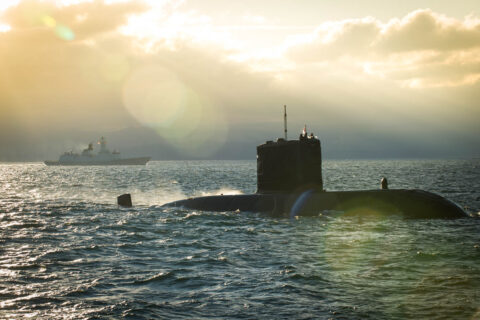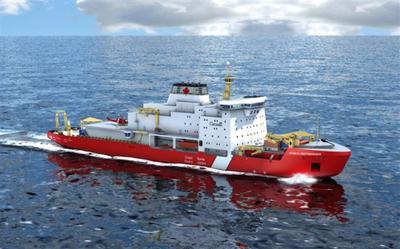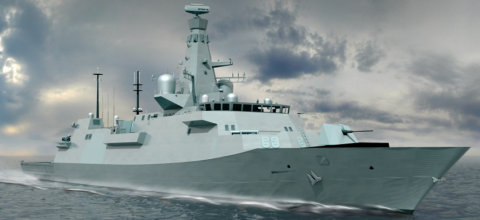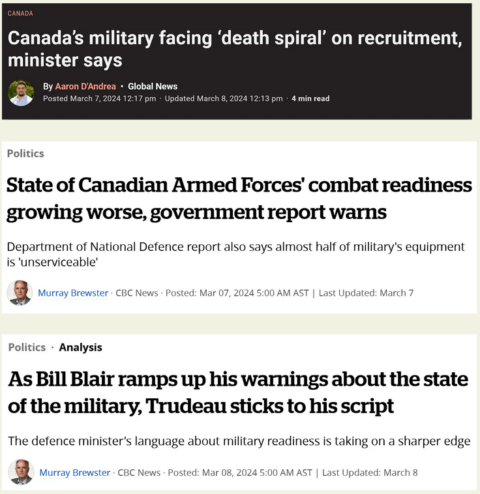Royal Canadian Navy / Marine Royale Canadienne
Published 10 Nov 2024Canada’s “most fightingest ship” served in our Navy for 20 years between 1943 and 1963. The last Tribal Class Destroyer in the world, it and its company persevered through the Second World War, Korean War and Cold War.
The ceremonial flagship of our Navy, HMCS Haida was saved from the scrapyards and now rests in Hamilton as a museum ship, a Parks Canada National Historic Site.
One of HMCS Haida‘s Captains was the Naval hero Harry DeWolf — the namesake of the Harry DeWolf Class of ships. The grandson of a Veteran who served on the ship recently took the leadership of HMCS Harry DeWolf for a tour after arriving alongside, showing the stark differences between the newest vessels of our fleet and this vintage destroyer showing the many differences between life in the Navy then and now.
#CanadaRemembers #HelpLeadFight
March 13, 2025
Leadership of HMCS Harry DeWolf take a TOUR of HMCS Haida National Historic Site, Parks Canada
March 6, 2025
HMCS Bonaventure – The Pride of Canada’s Fleet
Skynea History
Published 22 Oct 2024For today’s video, we’ll be looking at the last of Canada’s aircraft carriers. Not typically a navy you associate with that kind of ship, but the Canadians actually operated three during the Cold War.
The third, HMCS Bonaventure, is an interesting one. A small ship, that operated aircraft at the very edge of her capability. And routinely baffled American pilots in the process.
Yet, she was also a ship that came to an end before her time. Decommissioned and scrapped, right after an expensive (and extensive) mid-life overhaul. In what is generally seen as a bad political move, more than anything to do with her capabilities.
(more…)
February 12, 2025
Poilievre’s outlined plan for the Canadian Arctic gets the CDR Salamander seal of approval
Although most of the attention is on the still ongoing Trump tariff tantrum, there is still the required battle-space preparations going on for the next federal election. Conservative leader Pierre Poilievre discussed his proposals for improving national security in the Arctic, and CDR Salamander is enthusiastic:

Pierre and Ana Poilievre at a Conservative leadership rally, 21 April, 2022.
Photo by Wikipageedittor099 via Wikimedia Commons.
… here are the highlights as I see them.
- Canada’s Arctic is under threat. 75% of Canada’s coastline is in the far north, and 40% of her landmass. Canada needs to become self-sufficient.
- In the fall of 2022, the Canadian military found Chinese monitoring buoys in the Arctic.
- A Royal Canadian Navy frigate shadowed a Chinese research vessel in the Bering Strait off Alaska last year (thank you RCN friends, we don’t have any frigates nor naval bases in Alaska because … our leaders don’t understand much outside Norfolk, San Diego, or the Potomac).
- Russia is building new bases and infrastructure in the Arctic.
- Canada will take back control of Canadian waters, sky, and land.
- The Canadian military today is weakened and her allies no longer respects her.
- Canada does not have a permanent military presence in the Arctic.
- When Prime Minister, he will increase Canadian forces by:
– Doubling the size of the Canadian Rangers from 2,000 to 4,000 Rangers.
– Acquire two additional polar heavy icebreakers for the Royal Canadian Navy by 2029 on top of the two current icebreakers being built for the Canadian Coast Guard.
– Will build Canada’s first permanent Arctic military base since the Cold War. It will be CFB Iqaluit. 100% of the cost of the base will come out of the Canadian foreign aid budget and will be up and running within two years of Poilievre becoming Prime Minister.
– New submarines.
- Bringing wasted foreign aid back to Canada.
- If Canada wants to be a sovereign, self-reliant nation, it must take control of their north, secure its borders, and stand on its own two feet.
- Canada cannot count on the Americans to do it for them.
Further on in this speech, Poilievre speaks out strongly against some of the statements of President Trump and his administration, and that is fine for me. Were I Canadian, I would say very similar things. This is OK. Friends can have disagreements now and then, but for every one item that causes friction, we will always have nine items that bring us together.
It’s all good.
January 4, 2025
Winning WW2’s Most Important Battle – Battle of the Atlantic
Historigraph
Published 15 Aug 2024The Second World War featured many important land battles on a colossal scale. They involved hundreds of thousands of participants, ranged across hundreds of miles and inflicted the most terrible destruction. But none of them were as long-running, as vast or as crucial to allied victory as that fought at sea in the Atlantic, where for four years Allied navies and civilian sailors fought a life or death struggle against Germany’s U-boats. This is the story of how it was fought, and how it was won.
00:00 – WW2’s most important battle
00:45 – The U-boat menace in the early years
08:53 – The massacre off the eastern seaboard
13:12 – American ship printer go brrrrrrrrr
19:31 – The Allies gain the upper hand
21:49 – Black May: the convoy battles of 1943
24:41 – The most important victory of WW2
(more…)
December 3, 2024
Canadian Armed Forces: Can the RCN Really Stop Russia and China in the Arctic?
Esprit de Corps Canadian Military Magazine
Published 2 Dec 2024Vice Admiral Angus Topshee recently told the National Post that the Canadian Navy is able to defend our Arctic waterways against China or Russia … without help from our allies (aka the US Navy). It is time to target just what the heck the Admiral is talking about!
November 28, 2024
Town-class destroyers – Guide 400
Drachinifel
Published Aug 3, 2024The Town class destroyers, old Wickes, Clemson and Cadwell class vessels of the US Navy, transferred to the British Royal Navy and others, are today’s subject.
(more…)
July 23, 2024
Trudeau announced new submarines for the RCN … don’t assume he’s really serious
At The Hub, J.L. Grantastein explains why Trudeau’s hasty commitment under pressure from our exasperated NATO allies is not likely to be met, and almost certainly not to be met fully:

HMCS Chicoutimi escorts Peoples Liberation Army (Navy) ships visiting Victoria on behalf of the Chinese military, 13 December 2016.
Photo: Cpl Carbe Orellana, MARPAC Imaging Services, ET2016-0468-03 ©2016 DND-MDN CANADA
Canada has no capacity to construct submarines, and the country’s shipyards are struggling to build destroyers, icebreakers, and supply ships. This means that submarines will need to be purchased from European or Asian shipyards with experience in building them. (There will be a certain irony if the RCN, having fought against U-boats in two world wars, ends up with German submarines.)
As of Trudeau’s announcement, let us be clear, no submarine design has been selected, and naval officers are said only to have been engaged in seeking the best models for the RCN. Given Canada’s broken defence procurement system, this is unlikely to be a quick process. The RCN may soon know what it wants but the bean counters will rule as they always do, and orders most likely will not be placed for at least three to five years.
Few expect that the Liberals will be in power in 2027, and if the Conservatives do form the government, it is worth noting that Pierre Poilievre has refused to commit to a date for Canada to meet its 2 percent pledge. New subs may not be an idea the Tories will accept.
If an old or new government does decide to continue with a submarine program, it is certain that a new conventional sub will cost at least $1 billion, many millions more to make it strong enough to operate for long periods in the Arctic, and millions more for its torpedoes, missiles, other weapons, radars, and electronic systems. The costs involved all but guarantee that 12 submarines are a pipedream — the RCN will be lucky to get four to six. Trudeau did not offer a timetable in his remarks, but it is highly unlikely that even a single submarine would be ready to go to sea before the early 2030s and the last by the 2040s.
Then there is the problem of manning a fleet of underwater vessels. The RCN has four Victoria-class boats now. These subs, purchased used from the Royal Navy, have not worked well, are constantly undergoing expensive repairs, and scarcely leave the dock. In other words, the crews have relatively little sea-going experience, the RCN is short of sailors already, and experienced mechanics and skilled technicians are in even shorter supply. Each sub will need more than sixty officers and sailors, and there must be at least three times that number on leave, on courses, or in training to support each crew.
There is little point in acquiring new submarines if there are no crews to sail in them, and with the fifteen new destroyers planned and just beginning construction, the senior service’s personnel needs must be a top priority. That need will not be met until the Canadian Armed Forces’ problems with recruitment are fixed, and that problem has bedevilled the military for decades. (I served on a Department of National Defence Special Committee in 1995 that advanced recommendations to improve recruiting, but nothing changed. Nothing has improved in the three decades since.)
Note that referring to the navy as “the senior service” is only appropriate when talking about Britain’s Royal Navy. The Royal Canadian Navy was established in 1910, long after the Canadian Army came into existence. I’m sure members of the RCN won’t mind if you make that mistake, however.
July 12, 2024
New Canadian submarines and icebreakers promised at NATO Summit
Under reportedly intense pressure from NATO allies, Canadian Prime Minister Justin Trudeau grudgingly promises to begin the (usually decades-long) process of purchasing new submarines for the Royal Canadian Navy:
The Canadian government announced today it is “taking the first steps” towards buying 12 conventionally-powered, under-ice capable submarines — a massive acquisition with numerous shipbuilders from the around world already eyeing the program reported to be worth at least $60 billion Canadian dollars.
“As the country with the longest coastline in the world, Canada needs a new fleet of submarines — and today, we’ve announced that we will move forward with this acquisition,” Bill Blair, minister of national defence, said in a statement published during the NATO Summit being held this week in Washington, DC. “This new fleet will enable Canada to protect its sovereignty in a changing world, and make valuable, high-end contributions to the security of our partners and NATO allies.”
Canada has been eyeing the acquisition of a new class of submarines to replace its four aging Victoria-class boats since at least April 2023, and Blair himself was the target of criticism earlier this year after he included language about the acquisition in a major defense policy document that critics labeled as “wishy washy”.
In an op-ed for Breaking Defense published ahead of the NATO summit, Blair said that Canada was still pursing the submarine plan, and emphasized that the investment would help his nation cross the 2 percent GDP target.
The government’s press release does not include a price estimate for the program, but the Ottawa Citizen has previously reported that the Royal Canadian Navy tagged the acquisition at $60 billion Canadian dollars ($44 billion USD).
Another item from Breaking Defence details a new trilateral agreement with Finland and the United States to develop a joint design for a “fleet” of icebreakers:

Originally ordered in 2008 for delivery in 2017, the CCGS John G. Diefenbaker is now expected to enter service in 2030.
Canadian Coast Guard conceptual rendering, 2012.
The US, Canada and Finland announced today a new trilateral effort, dubbed the Icebreaker Collaboration Effort or “ICE Pact”, to work together on the production of a “fleet” of new polar icebreakers, in what a US official said was a “strategic imperative” in the race of dominance of the high north.
The initiative, to be formalized in a memorandum of understanding by the end of the year, calls for better information sharing on ship production, collaboration on work force development — including better allowing workers and experts to train at each other’s yards — and an “invitation” to other allies and partners to buy icebreakers from ICE Pact members.
“Due to the capital intensity of shipbuilding, long-term, multi-ship orderbooks are essential to the success of a shipyard,” the White House said in its announcement. “The governments of the United States, Canada, and Finland intend to leverage shipyards in the United States, Canada, and Finland to build polar icebreakers for their own use, as well as to work closely with likeminded allies and partners to build and export polar icebreakers for their needs at speed and affordable cost.”
Ahead of the announcement, White House Deputy National Security Advisor for International Economics Daleep Singh framed the partnership as a commercial and industrial boon, but also one with national security implications: It is, in part, a message to Russia and China that the US and its partners “intend … to project power into the polar regions to enforce international norms and treaties that promote peace and prosperity in the arctic and Antarctic.”
July 1, 2024
Letter from Britain / Canadian Soldiers (1945) – British Council Film Collection
Charlie Dean Archives
Published Sep 22, 2013Three Canadian servicemen visiting London discuss the experiences of Britain that they have been writing home to loved ones about.
Trivia:
This film was specifically produced for Canadian audiences, in order to boost the relationship between the two countries, although it did receive distribution in other countries as well.Letter from Britain and Ulster are the only two films in the British Council Film Collection to feature Northern Ireland. It is also unusual in that it features real servicemen, rather than actors.
The poster seen on the Underground train at 06:00 was part of the government-sponsored “Billy Brown of London Town” series.
Letter from Britain was filmed no earlier than March 1945, as this is when the “Merchant Navy” class steam train Elders Fyffes — seen at 04:40 — was built.
Several ships are seen around Londonderry in Letter from Britain. These include HMCS Glace Bay, HMS Launceston Castle, HMS Loch Katrine, HMCS Penetang, and HMCS Petrolia. By comparing convoy listings, it can be deduced that these scenes were filmed around 15 March, 1945.
The song sung by “Paddy” at 13:05 is entitled “If You Ever Go To Ireland”, written by Art Noel. The song sung by the solider around 14:45 is an Irish ballad called “The Rose of Tralee”. The piece sung in the pub around 15:40 is “My Gal’s a Corker”.
(more…)
June 5, 2024
HMCS Charlottetown: A formidable submarine-hunting force in Nato’s fleet
Forces News
Published Mar 1, 2024Conceived in the middle of the Cold War era, the Canadian Royal Navy frigate HMCS Charlottetown has evolved over three decades of service, becoming one of the most capable and adaptable ships in Canada’s navy.
After setting sail for Nato’s Exercise Steadfast Defender in the North Sea, she made a stop in Edinburgh en route to participating in the alliance’s largest training mission since the Cold War.
(more…)
May 29, 2024
Why Germany Lost the Battle of the Atlantic
Real Time History
Published Feb 2, 2024In March 1943, German U-boats are on the attack – they sink 108 Allied vessels that month alone. Some Allied officials fear a German victory in the Atlantic is imminent. If the Allies lose the Atlantic, Britain loses its lifeline – and maybe even the war. But by May 1943, it will be the U-boats limping home in defeat. So how, in just two months, did the U-boats go from hunters to hunted?
(more…)
May 15, 2024
Canada’s Minister of National Defence says new submarines are “inevitable”
Bill Blair regrets earlier comments that some read as weakening the government’s already feeble commitment to re-equipping the Royal Canadian Navy’s submarine branch:

HMCS Victoria, one of the four submarines currently in service with the Royal Canadian Navy. She was originally commisioned into the Royal navy as HMS Unseen in 1991 and re-commissioned as HMCS Victoria in 2000.
Image via Wikimedia Commons.
Bill Blair, the federal defence minister, made a rare admission of Liberal fallibility in Washington on Monday when he said he regrets using the word “explore” when talking about renewing Canada’s submarine fleet.
Ottawa’s recent defence policy update said the government will “explore options for renewing and expanding the submarine fleet”, a form of words that was criticized for lacking urgency.
“It’s certainly not my intention to be wishy-washy. What I’ve tried to articulate very, very clearly and strongly in the document is, we know we have to replace our submarine fleet, and we’re going to do that,” Blair said.
Replacing the four Victoria-class subs is necessary, he said. “It is, I might suggest, inevitable.”
That is absolutely the case, if Canada is committed to maintaining its submarine capability. The Victoria-class subs date back to the late 1980s and are due to be taken out of service at the end of the 2030s.
Submarines are seen as a crucial defence against incursion by hostile powers, as the polar ice melts and opens up northern waterways. The Northwest Passage is forecast to be the most efficient shipping route between Asia and Europe by 2050.
But Blair admits “there is a lot of work to do”, not least convincing his cabinet colleagues of the “business case for the capability”.
“One of the greatest challenges of being a defence minister is to secure funding and the second one is actually spending it”, he said on Monday.
He gave a sense of the struggles around the cabinet table last month in a speech in Ottawa, where he admitted: “I had to sort of keep on pushing my issue forward about the importance and the need to invest in defence”. He made it sound as if he was a lone voice in the wilderness.
[…]
Retired captain Norman Jolin recently wrote an analysis for the Naval Association of Canada that noted if Canada wants to maintain submarine capability, it needs to place a contract with a proven builder by 2027 at the latest. He said the lack of domestic submarine-building capacity means there is neither the time nor resources to even think about a made-in-Canada solution.
The typical procurement process takes 18 years to get from cabinet approval to delivery, which would mean if an order was placed tomorrow, we wouldn’t get new subs until 2042.
Based on that timeline, “it is clear that the decision to replace the submarines is considerably overdue,” Jolin wrote.
There’s little chance that this will move closer to completion during the remaining life of the current government, with an election due before the end of 2025, and Blair is already on the record emphasizing how little the Liberals would relish spending any money on military equipment even in good economic times. Oddly, the fact that there are no domestic shipyards currently capable of building submarines may be a positive — building the RCN’s ships in Canadian yards always means that each ship costs much more than if the hull is built in a foreign shipyard. Canada doesn’t have the facilities and trained workforce to build naval vessels, so every time a new class of ships is needed, the cost of building/refurbishing the shipyards and hiring and training-from-scratch a new workforce balloons the total cost of the program.
March 12, 2024
The recently admitted “death spiral” for the Canadian Armed Forces is nothing new
“Shady Maples” outlines just a few of the historical procurement fuckups Canada’s armed forces have had to work through, showing that the recent admission that the armed forces are in a “death spiral” by MND Bill Blair is almost “situation normal” for the troops:
The Canadian Armed Forces are fucked. By this term of art, I mean that the CAF:
- are in dire circumstances; and
- are being used for such aggressive political gratification that it’s practically perverse.
You don’t have to take my word for it. The Minister of National Defence made the following remarks last week:
because, the bottom line is the Canadian Armed Forces must grow. We’re short a lot of people. Almost 16,000 in our regular forces and reserves.
If that wasn’t bad enough, he added:
more than half of our trucks, more than half of our ships and more than half of our planes are not available for service because they are in need of parts and repair. We’re going to have to do better.
Translation: we are fucked.
The MND’s remarks come eleven months after the CDAI published an open letter on the state of national security and defence:
Years of restraint, cost cutting, downsizing and deferred investments, have meant that Canada’s defence capabilities have atrophied. Our military capabilities are outdated and woefully inadequate to protect our landmass and maritime approaches. We have also fallen short in meaningful contributions to burden sharing for the collective defence and security of our allies and partners.
Translation: we have been fucked for awhile.
More recently, the Vice Admiral Tophsee made waves on the RCN’s official YouTube channel by stating the obvious:
Colleagues and Shipmates, the RCN is facing some very serious challenges right now that could mean we fail to meet our Force Posture and Readiness commitments in 2024 and beyond. La situation est grave mais nos problèmes ne sont pas uniques et je sais que l’aviation et l’armée sont confrontées a des défis similaires. [The situation is serious, but our problems are not unique, and I know that the Air Force and the Army are facing similar problems.]
Translation: we will be fucked for the foreseeable future.
He then shows that this sort of thing has been part-and-parcel of Canada’s delusionary approach to national defence since the year before Confederation. Canada’s WW1 army was sent off with fantastically bad equipment — from rifles to web gear, from automobiles to artillery ammunition — all scandals of the day that no lessons were learned from.
Soldiers and officers at the tactical level will readily tell you that these headlines are only surprising because senior leaders are finally saying the quiet part out loud: the CAF is undermanned, under-equipped, under-trained, and unprepared. We know this because we live it every day: situation normal, all fucked up. But you don’t need a source or a leak to learn about our deplorable state of readiness. Here is a link to DND’s 2023 audit and evaluation reports. They paint a bleak picture: we have insufficient equipment and what we have keeps breaking. We have insufficient personnel to match with commitments, and we are struggling to recruit, train, and retain more. Go have a look at the reports, they lay it all out.
March 8, 2024
Know Your Ship #20 – Flower Class Corvettes
iChaseGaming
Published Oct 27, 2014Episode 20 of Know Your Ship! In this educational video I cover the Flower class corvettes. These corvettes used by the Royal Canadian Navy and the Royal Navy to great effect during the Battle of the Atlantic. The Flower class were built quickly and cheaply in order to provide as many ships for convoy duty and anti-submarine operations as possible. The Royal Canadian Navy in particular achieved significant success and became experts in anti-submarine operations. Sadly, these ships and their crews are mostly forgotten with the passage of time as attention is mostly given to the surviving capital ships. It is my hope that this educational video will help people to understand and know these important ships that helped safeguard the convoys during World War 2. The only remaining ship of this class is HMCS Sackville which you will see later in this episode.
(more…)
January 26, 2024
Canada’s sooper-sekrit warship program
David Pugliese on the cone of silence the federal government seems to have pulled down over the Canadian Surface Combatant shipbuilding program as it steadily escalates in total cost to the taxpayer:

An artist’s rendition of BAE’s Type 26 Global Combat Ship, which was selected as the Canadian Surface Combatant design in 2019, the most recent “largest single expenditure in Canadian government history” (as all major weapon systems purchases tend to be).
(BAE Systems, via Flickr)
National Defence has brought in a new and unprecedented shroud of secrecy around a controversial warship project now estimated to cost taxpayers more than $80 billion.
After withholding documents for almost three years, the Department of National Defence has released nearly 1,700 pages of records that were supposed to outline specific costs and work done so far on the Canadian Surface Combatant program.
But all the details of what taxpayers have so far spent and what type of work has been done by Irving Shipbuilding for that money have been censored from the records.
“I pretty much got nearly 1,700 blank pages,” Ken Rubin said of the access to information request he filed to National Defence in April 2021 about the warship program. “I have never seen this level of secrecy or lack of accountability over a project that is costing so much.”
Rubin, an investigative researcher who has used the access law to obtain federal documents for decades, said there was not a single cost figure contained in any of the 1,700 pages. One page noted that Irving was required to perform 19 specific tasks, but all details were censored. Others pages listed numerous amendments made to the CSC program, but all details were blacked out. Information about the annual profit Irving has made so far on the CSC project is censored.
Irving declined to provide comment, referring this newspaper to National Defence.
Defence Minister Bill Blair’s office sent this newspaper a statement noting the “minister believes strongly in openness and transparency, and expects the Department of National Defence to respect the rights of Canadian citizens, permanent residents and persons or corporations present in Canada, to access records of government institutions that are subject to the Access to Information Act“.
National Defence noted in a statement that, since some of the records involved Irving Shipbuilding, government officials consulted with the firm to determine if the records contained proprietary information of the firm. Irving objected to the release of information, the department added.
But Rubin pointed out that National Defence was not required to follow Irving’s orders on what records could be released to the public. The amount of tax dollars spent on the surface combatant and how that money was being spent shouldn’t be secret, he added.
In addition, National Defence originally claimed in a statement to this newspaper that the long delay in providing the documents was because Rubin had asked for 20 years of records. But, when challenged on that claim, the department acknowledged it wasn’t true. It did not, however, provide an explanation why it had provided false information to this newspaper.
The Canadian Surface Combatant project will involve the construction of 15 warships for the Royal Canadian Navy at Irving on the east coast.





